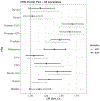Performance of polygenic risk scores for cancer prediction in a racially diverse academic biobank
- PMID: 34906489
- PMCID: PMC9680700
- DOI: 10.1016/j.gim.2021.10.015
Performance of polygenic risk scores for cancer prediction in a racially diverse academic biobank
Abstract
Purpose: Genome-wide association studies have identified hundreds of single nucleotide variations (formerly single nucleotide polymorphisms) associated with several cancers, but the predictive ability of polygenic risk scores (PRSs) is unclear, especially among non-Whites.
Methods: PRSs were derived from genome-wide significant single-nucleotide variations for 15 cancers in 20,079 individuals in an academic biobank. We evaluated the improvement in discriminatory accuracy by including cancer-specific PRS in patients of genetically-determined African and European ancestry.
Results: Among the individuals of European genetic ancestry, PRSs for breast, colon, melanoma, and prostate were significantly associated with their respective cancers. Among the individuals of African genetic ancestry, PRSs for breast, colon, prostate, and thyroid were significantly associated with their respective cancers. The area under the curve of the model consisting of age, sex, and principal components was 0.621 to 0.710, and it increased by 1% to 4% with the inclusion of PRS in individuals of European genetic ancestry. In individuals of African genetic ancestry, area under the curve was overall higher in the model without the PRS (0.723-0.810) but increased by <1% with the inclusion of PRS for most cancers.
Conclusion: PRS moderately increased the ability to discriminate the cancer status in individuals of European but not African ancestry. Further large-scale studies are needed to identify ancestry-specific genetic factors in non-White populations to incorporate PRS into cancer risk assessment.
Keywords: Cancer risk; GWAS; PRS; Polygenic risk score; Racial differences.
Copyright © 2021 The Authors. Published by Elsevier Inc. All rights reserved.
Conflict of interest statement
Conflict of Interest S.M.D. receives research support to the University of Pennsylvania from RenalytixAI and consulting fees from Calico Labs, both outside the current work. S.M.D. is named as a coinventor on a Government-owned US Patent application related to the use of genetic risk prediction for venous thromboembolic disease filed by the US Department of Veterans Affairs in accordance with Federal regulatory requirements. M.D.R. is on the scientific advisory board for Goldfinch Bio and Cipherome. The remaining authors declare no conflicts of interest.
Figures

References
Publication types
MeSH terms
Grants and funding
LinkOut - more resources
Full Text Sources
Medical

